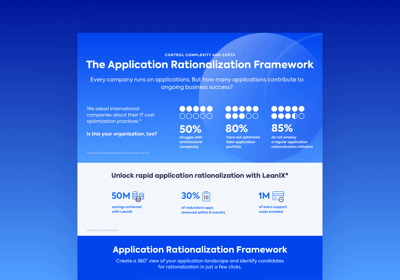1. Do it once
If companies don't cut deeply or efficiently enough the first time, they may need to repeat the process more than once. This drives uncertainty, loss of productivity, and could lead to other more serious problems down the line. This may include loss of morale and possible insecurity.
2. Map the IT landscape
IT cost optimization will evaluate expenditure throughout the entire IT landscape – which means you need to track the inventory of IT resources. IT visibility is a key part of cost optimization. A thorough, accurate inventory of your IT landscape and visually mapping it are essential to any potential tech stack optimization.
The LeanIX Enterprise Architecture Management (EAM) and SaaS Management Platform (SMP) are two of the tools which provide visual maps for organizations to evaluate their IT environments. That way, leaders can make informed decisions about where value can be maximized.
The SMP and Application Portfolio Management (APM) allow businesses to discover which On-Prem and SaaS applications already exist within the IT landscape and what business units they are part of. From here, architects can visualize where money is being spent. They can also quickly rationalize based on the respective lifecycle stage, usage, business value, and risk.
3. Define baseline
Before making any cost-saving decisions, a baseline needs to be defined. This involves collaborating with stakeholders and business leaders to establish a clear and structured approach to what cost-saving strategies are necessary. Questions IT architects need to establish with stakeholders before cost-cutting include:
- Determine the desired result. What does the organization wish to achieve through IT cost reduction?
- Next is the timeframe. Stakeholders and IT architects need to determine how long it will take to make the necessary cuts, as well as how long it will take for the business to see whether this has succeeded or not.
- Lastly, teams will need to determine the best approach. How will the business tackle the issue? What needs to be done and what steps must be taken to ensure the project’s success?
4. Target instant impact
Fast IT cost reduction involves targeting areas of instant impact. This means eliminating, reducing, or suspending items that will deliver the results in days, weeks, or months rather than years. You can do this by eliminating services, rationalizing assets, projects, personnel, and renegotiating contracts.
5. Focus on cash
The goal of IT cost reduction is to release cash quickly in a way that affects the profit and loss statement, rather than non-cash items. Reexamining cloud services is a great opportunity to release money, as there are many strategies you can use to negotiate or evaluate cloud systems so that they are better aligned with the monetary and functional needs of the company.
6. Reduce, don't freeze
Make sure you reduce or eliminate costs right away, rather than freeze them. This is important because frozen costs may return to haunt the balance sheet down the line. In this way, it’s beneficial to take a more determined approach to IT cost cutting.
READ ON BELOW


/EN/White-Paper/EN-IDC-Inforbrief-Application-Rationalization-Portfolio-Management-Thumbnail_v2.png?width=260&height=171&name=EN-IDC-Inforbrief-Application-Rationalization-Portfolio-Management-Thumbnail_v2.png)

/EN/Reports/Thumbnail-Gartner%20720x500.png?width=260&height=171&name=Thumbnail-Gartner%20720x500.png)



